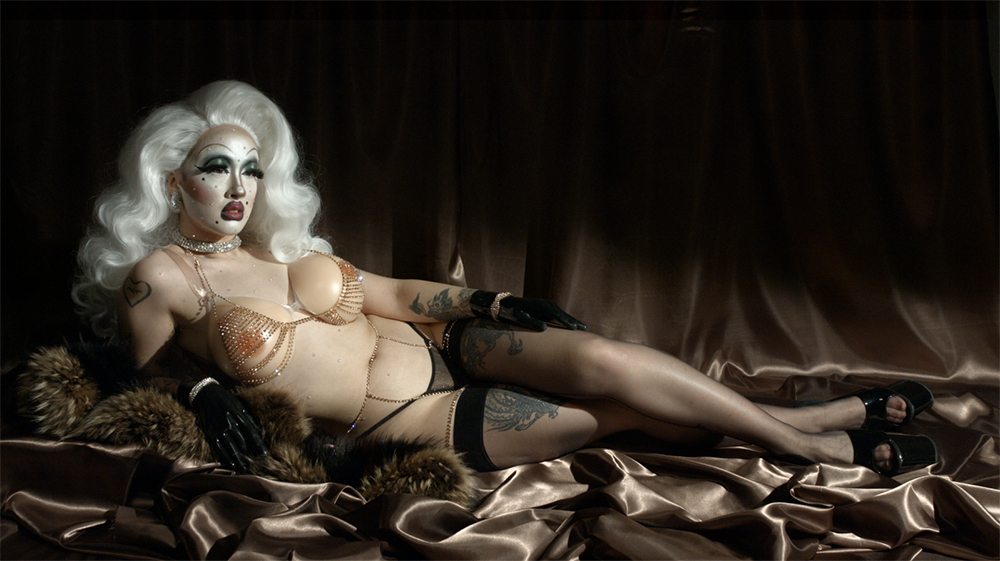By Antonis Sideras, MFA Fine Art Graduate at Wimbledon College of Arts

Victoria Sin
Held at the HENI project space at the Hayward Gallery, the exhibition titled ‘DRAG’ stays true to its promise to showcase images in which artists capture their departure from the binaries which encase gender. Featuring a range of artists from various backgrounds gives the show a distinct dynamic; the works of established artists from the late 20th century is curated alongside that of emerging artists working across art and drag, and also that of lesser known hybrid performers from the past. This makes the show feel more like a study on the history of gender shifting from the 1970’s onwards.
Arguably the stand out of this exhibit was its moving image collection. As you walk through the exhibition, your gaze is captured by the low-fi image of Leigh Bowery appearing in an old box tv monitor. The only way to describe Bowery’s appearance is ‘extravagant’. As you may know Bowery’s provocateur image was built on wearing outlandish costumes in the hot club scenes of New York and London in the 1980’s. However, his visual feast comprising of bold colours and patterns was also present in other contexts: The video captured by Cerith Wyn Evans shows a green Bowery covered in orange polka dots, reclining on a beige divan sofa at Anthony D’offay Gallery. Lit by harsh stage lighting, the video focuses on Bowery feeding off the gaze of the audience lurking in the dark – consolidating his status as an indisputable queer spectacle.

Leigh Bowery
The Leigh Bowery video was strategically positioned next to that of Victoria Sin. An ultra HD video portrait of Sin in drag was shown on a state of the art large flat screen sat next to Bowery’s video. The stark antithesis of the two broadcast techniques places the two works in a timescale of ‘then’ and ‘now’, allowing the general public to observe the changes in queer aesthetics through thirty years of drag ‘herstory’.
Victoria Sin is someone I discovered at the show; a non-binary drag artist who allows signifiers of feminine beauty to explode in their face, resulting to a hyper-feminine, heavily contoured appearance. Their 2018 video portrait titled ‘Tell me everything you saw, and what you think it means’ finds a scantily dressed Sin assuming a reclining Venus position on a bed of chocolate coloured satin. Their body is decorated with tiny crystals, and long ash-blonde locks fall onto their almost translucent black bra filled by a sizeable plastic breast plate. Sin’s true wit is seen, or rather heard in the audio accompanying the video: A female sounding voice deconstructs the visual cues which “should” make this image attractive according to the male gaze – as observed through centuries of Western art. However, Sin inflates these signs to the point where they transgress from being “sexy” to “ridiculous”. Their approach follows a feminist x non-binary school of thought stemming from theorists like Judith Buttler who argue that gender is essentially a game of dress up.

Rose English
The perfect companion to Victoria Sin would undoubtedly be English Rose, whose work could not have been missed in DRAG. Rose English has had a long career of making feminist and gender-oriented works since the 1970’s. In some instances, English has been seen as a woman, impersonating men who impersonate women. This becomes apparent whilst watching the excerpt of her 1992 performance ‘My Mathematics’: English is spotted wearing a silver mermaid gown and a pair of long red gloves, whilst balancing a tower of blonde hair on her head. The prominent feature of her ensemble is a pair of extremely long eye lashes. This clearly references the overstated way in which femininity has been staged by male drag queens. ‘My Mathematics’ takes the form of a stand-up comedy act: English stands on a bare theatre stage, which she fills with her exaggerated mannerisms and strong one-liners. Throughout the excerpt, English seeks volunteers from the audience to engage with her in the following ways: share a passionate kiss with the tall beauty, be lashed by her eyelashes, or even accept both. These actions mock the duality of female characters portrayed in phallocentric narratives, which paint women as creatures that can be tentative and dangerous at the same time. English’s amplified portrayal of femininity aligns itself with that of Victoria Sin, and together they highlight the tipping point where stereotypical expressions of femininity turn into parodies of gender.
Ultimately, ‘DRAG’ argues that transformative processes associated with gender bending are inherently political statements speaking up against the heteronormative status quo through their non-conformism to gender binaries. Furthermore, the exhibition embraces the very much contemporary notion that drag can be instigated by any type of body – be that a body read as male, female, or non-binary. Policing the process of mocking gender stereotypes feels like a futile exercise anyway.

